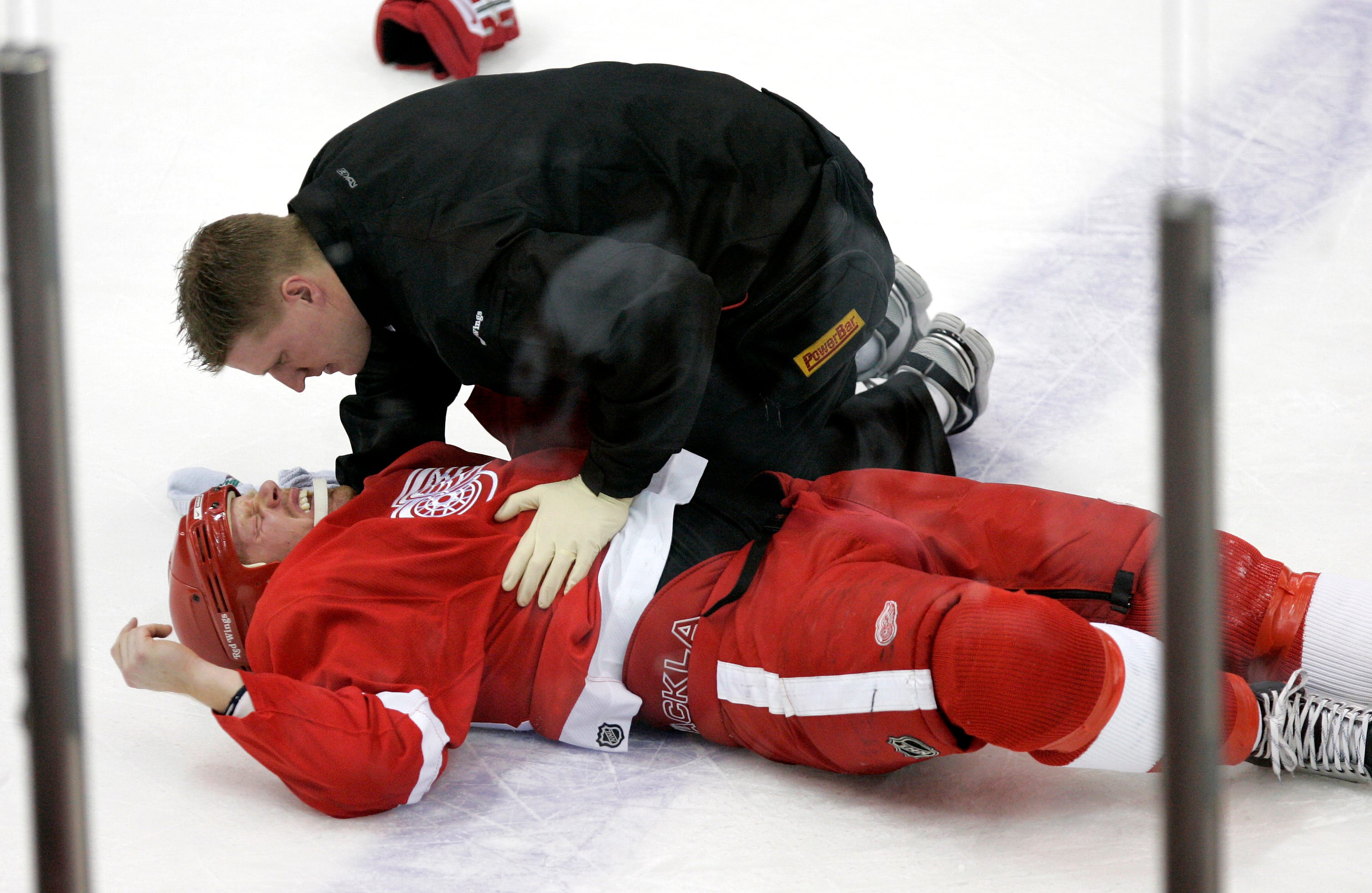Concussion suits against NHL face headwinds
 Gregg Krupa
Gregg Krupa
Detroit — The legal strategy of the NHL to defeat a class-action suit by players concerned about brain injuries might prove successful, but the issue of legal responsibility for potential long-term effects of brain trauma remains at issue, according to legal experts.
In attempting to settle suits filed by 146 former players, the league last week accepted no liability for the injuries.
Medical experts say the repetitive impact of body contact in hockey, including concussive and sub-concussive hits, can cause chronic traumatic encephalopathy (CTE), a neurodegenerative disorder.
The NHL disagrees.
Some players who filed suit, claiming the league knew more about the dangers and could have done more to protect and care for them, may choose to opt out of the settlement and pursue their cases.
And, some legal hurdles remain before the settlement is final.
But, while participation rates in hockey remain high and are increasing in the United States, and current players say they are well-informed of the issues and feel as protected as they can be, health issues related to a sometimes vicious body-contact sport are likely to see a day in court.
While the proposed settlement establishes no liability for the NHL, it does not mean the league is not ultimately liable for some of the health consequences of the sport.
“As is the case in almost all settlement agreements, the defending party, the NHL, denies any liability, and both parties agree that there was no liability on the part of the NHL,” said Marc Edelman, a sports lawyer and professor of law at City University of New York.
“This does not mean that in the real world there is any objective evidence that the NHL is not liable.
“Moving forward, any plaintiff continues to have to prove his case against the NHL. There will continue to be litigation against the NHL by individual plaintiffs who opted out of the settlement.”
The legal strategy of the NHL has assured the number of plaintiffs is likely to drop substantially, experts said.
And, any players who continue will expend considerable time and costs, Edelman and others said.
“The NHL has engaged in a hard-nosed litigation strategy, in what is, quite frankly a case that has some difficulties from a legal point of view,” Ronald Katz, the former head of the sports law practice at the national law firm Manatt, Phelps and Phillips.
Future cases likely
Establishing a group of plaintiffs similar enough to compose a class and encouraging courts to govern the relationship between employers and employees, especially with union, management and contractual relations in place, were difficult barriers for the players’ litigation, legal experts said.
The legal effort now faces significant financial issues, which would have been resolved proceeding as a class of plaintiffs.
“Basically, the lack of class certification became the death knell of the case, and why they settled for peanuts,” Katz said.
“It’s just so difficult to proceed player-by-player. It’s not remunerative.”
But further litigation is likely.
First, by terms of the proposed agreement in the current cases, if any of the plaintiffs opts out, the NHL retains the right to terminate the agreement.
If enough players opt out, the NHL might decide to pursue further mediation.
But, that the experts said that is unlikely.
U.S. District Judge Susan Richard Nelson must approve the settlement.
Nelson denied class certification in the case in July saying, in part, that the court would be unable to fashion a universal remedy in the case because the plaintiffs lived in different countries and different states with markedly different health care options.
The settlement calls for a payment of at least $22,000 for settling filed and unfiled claims, neurological testing and assessment financed by the league and a fund to pay up to $75,000 in medical treatment.
A separate fund would support retired players in need.
The NHL would also pay $7 million in plaintiff legal fees.
There are 146 plaintiffs. The players have 75 days to opt out.
Among those likely to decline settlement and seek personal injury claims are Daniel Carcillo, Nick Boynton and the family of the late Steve Montador.

Carcillo said he will pursue his own case and issued a call for unity and resolve among the players.
“We knew this was coming,” Carcillo said. “This is just the beginning. Now the real campaign starts.”
For months, Carcillo’s Twitter account has featured his thoughts on brain trauma and hockey. When NHL announced the settlement, Carcillo tweeted, “Today was a highly emotional day for me. I’m home with my son now, holding him. Having a good cry.
“It’s hard to imagine losing my memory and possibly one day not recognizing his face.
“Am I going to die at a young age because I played hockey for a living?
“I need my day in court,” he tweeted. “I need my deposition made public. I want people to know the truth about the level of care the NHL provides a human being.”
Montador’s family is suing after the former defenseman’s autopsy revealed extensive CTE.
High incident rates
Several studies reveal ice hockey ranks among the sports with the highest incidences of concussion and sub-concussion brain trauma, and doctors at the Center for the Study of Traumatic Encephalopathy, Boston University School of Medicine, have found CTE in the brains of several prominent hockey players.
While concussions present concerns, and are more frequent in hockey, it is the repeated sub-concussive blows from body-checking and on-ice conditions that present the gravest threat of CTE.

The effects can be devastating.
The Red Wings’ Johan Franzen apparently continues to suffer serious post-concussion complications.
Attempts to talk to Franzen have been mostly unsuccessful since he left the Wings lineup after concussion symptoms returned in October 2015.
But in a blog last spring, his wife Cecilia wrote about the difficulties of his recovery, during treatment Franzen received at the Marcus Brain Health Institute in Colorado.
“I don’t know where to start, but his week has been really hard and extremely emotional,” her blog read, 30 months after her husband’s last game.
“He’s still dealing with post-concussion syndrome, and the last months have been really bad.
“Living with a husband with a brain injury is not easy, it’s like a roller coaster. But I am doing my best to get us to a better place, not only for us and but also for our amazing boys that deserve the best!”
Franzen’s teammate Niklas Kronwall said he is reticent to discuss the situation.
“Johan, I think if he wants to talk about it that’s on him,” Kronwall said.
“Just in general, it’s tough to understand until you really see it up close.”
Public health officials, including former athletes who have suffered concussions, have criticized the public stance of the league.
“I think the NHL is placing profits over people in how they’re discussing CTE,” said Chris Nowinski, co-founder of the Concussion Legacy Foundation, a nonprofit research and policy group.
“If they admit the obvious link, they increase future damages. And so, they are preferring to lie to the American public to protect their assets, while there are children who are playing ice hockey who might actually still believe them because they are the NHL.”
Growing sport
Despite the health concerns and clear danger, participation statistics kept by USA Hockey suggest the popularity of playing the sport is growing.
The national governing body of the sport, which certifies coaches and officials, reported record-high participation for males and females 18 years old and younger in each of the past five years.
The total of 382,514 last seasons was a 9 percent increase over five seasons before, and 11 percent in a decade.
In that decade, the number of players 8 years and younger has increased by 33 percent.
Seven years ago, USA Hockey banned body-checking in pee wee games, for players 11 and 12 years old. Checking is permitted in bantam hockey, for 13- and 14-year-olds.
In the NHL, players say they are well-aware of the dangers and protect themselves.
They say they monitor themselves after heavy hits and working hard on conditioning.
“You think about it, but it’s not something that really concerns me,” said Joe Hicketts, the rugged Red Wings defensemen who regularly delivers the sort of solid body checks that can jostle the brain.
“You have this mindset that you are playing to win, and sometimes you have to put your body in situations where it might not be the safest thing to do.
“There’s been a lot of research and passed along is the message that if something doesn’t feel right, that’s when you say something,” Hicketts said.
Michael Rasmussen, the Wings’ first-round pick in the 2017 draft, said he accepts the concerns as part of playing hockey.
“If you have a headache or take a hit to the head, they have protocols for it,” the 19-year-old forward said. “They take good care of us.
“It’s not really on my mind, unless it’s important.”
gregg.krupa@detroitnews.com
Twitter: @greggkrupa